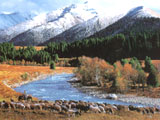 The Ili Valley is located in the northwest part of Xinjiang, about 60 kilometers east of the Kazakhstan border. Endowed with a pleasant climate, breathtaking natural beauty and colorful ethnic customs, it has become one of the most popular tourist spots in Xinjiang.
The Ili Valley is located in the northwest part of Xinjiang, about 60 kilometers east of the Kazakhstan border. Endowed with a pleasant climate, breathtaking natural beauty and colorful ethnic customs, it has become one of the most popular tourist spots in Xinjiang.
Ili is home to nearly 20 ethnic groups, and each has its own distinctive lifestyle and folk customs. One good place to experience the unique features of Xinjiang’s diverse ethnic groups are the bazaars in the city of Yining, the political and economic center of the Ili region. The bazaar is where local people trade all kinds of goods. Here you can meet people from various ethnic groups and find all kinds of local handicrafts and delicacies, as well as many exotic articles from countries surrounding Xinjiang.
Yining is a major industrial city in the Ili region. The historical influence of Russian architecture has left the city with some very unusual and impressive landmarks. Russian invaders marched into Yining in the 1870s and stayed for several decades. They left behind many buildings imbued with a Russian style and design, with carved window frames and painted shutters.
The Ili area is best known for the Ili River, about 16 kilometers south of Yining city. Originating in the Tianshan mountains, the river winds its way westward through the Ili valley, and finally spills into Lake Balkhash in Kazakhstan. The river banks present a magnificent vantage point for viewing the snow-covered mountains and verdant forests. The enormous Ili Bridge is considered the best location for watching and filming the setting sun, and remains a favorite with many photographers.
From the Ili Bridge, visitors can take a two-hour bus ride to the famous Sayram Lake, lying in a basin in the western part of the Tianshan mountains. Syaram comes from the Kazakh language, and literally means "blessing". About 2,000 meters above sea level, Sayram lake is the largest alpine lake in Xinjiang, with an area of 450 square kilometers and a depth of 85 meters. Due to the high altitude and cold climate, the average temperature of the lake is just 5 degrees Celsius, so that even in summer the water may feel icy-cold.
The limpid and placid water stretches far into the distance, and gives the impression of having connected seamlessly with the blue sky. It is surrounded by vast grasslands, which provide ideal grazing land for the local Kazak and Mongolian herdsmen. The pastures are dotted with the yurts of the herdsmen, and sheep and goats amble around at a leisurely pace.
The serene Sayram Lake turns into a sea of festivity and happiness every August, when local Mongolian people hold their annual Nadam fair. At this time, the lakeside is filled with people from various ethnic groups, dressed in their traditional costumes. They come to the lake to trade or take part in all kinds of entertainment and competitions, such as archery, wrestling and horse racing. The fair is great fun for locals and tourists alike. If you want to, you can also join them in the interesting activities and games.
Near the Sayram Lake there is another famous tourist attraction called Fruit Valley. It is actually a mountain passage that serves as an important gateway between Ili and the outside world. From the bottom of the valley to the mountain slopes on either side, visitors can simultaneously enjoy the scenery of all four seasons. The place is known not only for its natural beauty, but also for the abundance of wild fruit trees, especially apple trees. Apples from the Fruit Valley are one of the Ili regions most famous exports.
From the Fruit Valley one can take a bus northwest to the ancient city of Huiyuan. Built in the 1760s during the Qing Dynasty, the city is where the government offices of the Ili General were located. It was also the political and military center of Xinjiang during the Qing period.
The ancient city is criss-crossed by four main streets, each leading to a gate tower on all four sides of the five-meter-high city wall. In the city center stands a three-story drum and bell tower, which is built of brick and decorated with exquisite paintings and carvings. Climbing onto the top of the tower, visitors can enjoy a panoramic view of the whole city. In the east of the city lie the office buildings of Ili’s General. The rooms, pavilions, towers and corridors are all well preserved, and a visit here allows tourists to catch a glimpse of the ancient history of Ili.
Geographically enclosed by the formidable Tianshan mountains, in the past Ili was less popular than some other tourist places in Xinjiang. But today, as transportation has improved, the place has become increasingly popular with tourists from home and abroad. Ili is inaccessible by train, and for going there, visitors can fly to Urumqi, the capital of the Xinjiang Uygur Autonomous Region, and then take a plane or long-distance bus to Yining city.
There is a saying in China that you don’t know how large the country is until you have been to Xinjiang. And there is a saying in Xinjiang that you don’t know how beautiful the place is without going to Ili. So, if you travel in Xinjiang, a trip to Ili is a must, and you will find it a worthwhile and memorable experience.
(CRI October 24, 2002)
|

